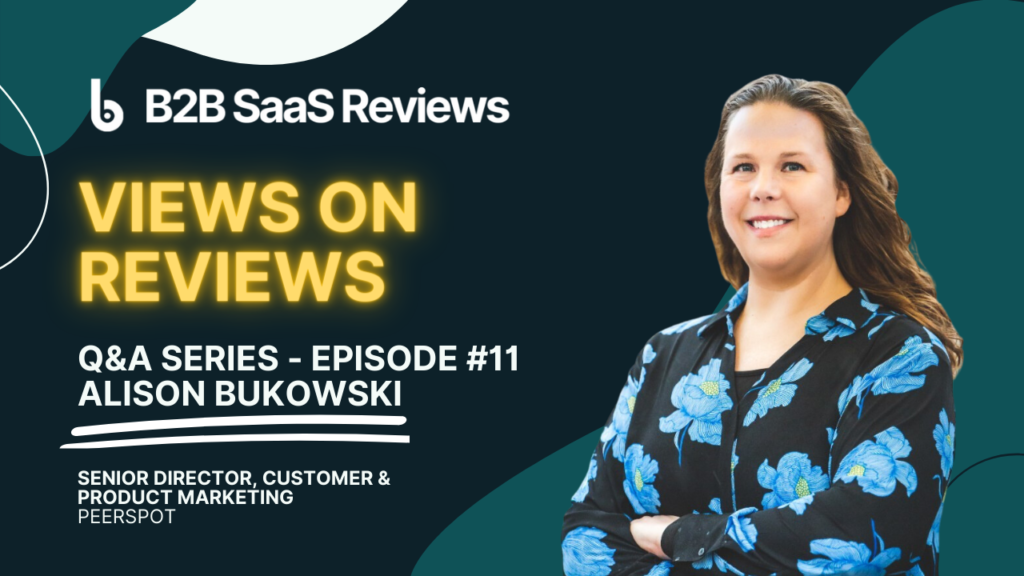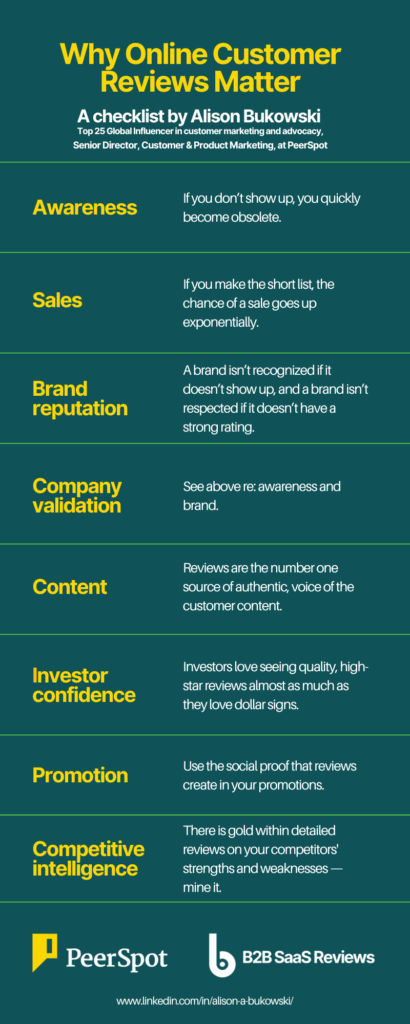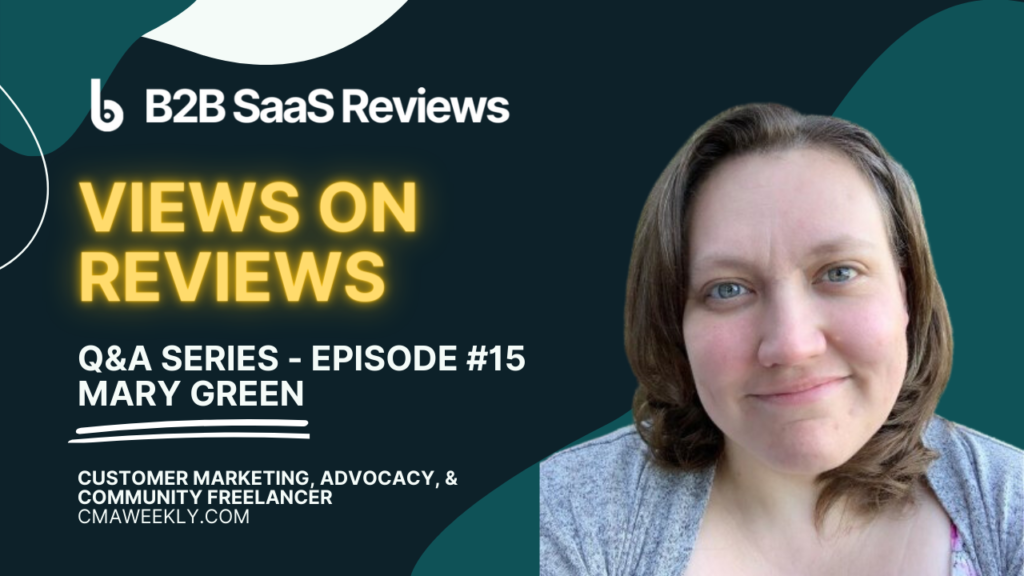Views on Reviews is a series of interviews with B2B SaaS professionals who provide a real-world perspective on what it’s like working on reviews. The eleventh interview is with Alison Bukowski, Senior Director, Customer & Product Marketing at PeerSpot.

Alison Bukowski is the Senior Director, Customer & Product Marketing at PeerSpot, a buying intelligence platform for enterprise technology buyers that features peer reviews.
In 2022, she was recognized as a Top 25 Global Influencer in customer marketing and advocacy.
Alison is actively engaged in the customer marketing and advocacy community. She is a CMA Exchange Vision Board of Directors member and the Associate Dean of the CLG Campus (Customer-Led Growth).
A regular speaker on the conference circuit, she most recently presented Demystifying Peer Reviews: Creating a Diversified Review Strategy at Base’s Obsession 2022 conference.
You can also listen to Alison discuss customer marketing and advocacy on her new podcast with PeerSpot, The CustomerX Files.
Without further ado, here are Alison’s views on reviews.
Key Takeaways
If you’re short on time, here are six key takeaways from the interview:
- Create a diversified review strategy: Creating a diversified review strategy is ensuring you’re aligning your goals with what the various review platforms can provide. It also means having a diverse group of reviewers and a diverse set of ways to ask your review candidates for a review.
- Match your goals to review site strengths: When deciding which review sites to work with, first consider your goals and what you want to achieve with peer reviews, and then do a thorough investigation of review platforms so you can match your needs to their strengths.
- Align your review requests with your customer journey: Build a customer journey map, or use an existing one to help determine when to ask for reviews. A critical part of building a diversified review strategy is soliciting reviews at the right time and place on the customer journey (e.g., after a successful deployment, after a promoter score on an NPS survey, post-renewal, etc.).
- Consider reviews as full-funnel: Reviews are one of the only pieces of content present from the top of the funnel to the bottom: we read reviews to narrow our search. And then, once we have our top contenders, we return to review sites, digging deeper into the details.
- Assign one person to monitor reviews: Have one person monitor your reviews and quarterback the feedback and responses. This is often done by a customer marketing/advocacy manager.
- Bookmark Alison’s eight reasons why online customer reviews matter: awareness, sales, brand, company validation, content, investor confidence, promotion, and competitive intelligence.
For more detail, here’s my interview with Alison.
How do you demystify online customer reviews?
You and I talked about how we each found our way into the world of software reviews, which you’ve also discussed with Margot Leong on her podcast, Beating the Drum (episode linked below). Mind re-telling us how you got here?
I worked in academia and non-profit early in my career, but my roots have always been in content/writing. I was an English major and determined to carve my own path. I worked on federal research grants, researching and writing, then wrote grants for animal welfare organizations to secure funding.
As I moved to corporate America (I’ve spent the past nearly 20 years in healthcare or technology), I worked as a content manager, marketing copywriter/editor, and back to proposals.
My obsession with customer service, coupled with a short stint in training and development, led me to customer advocacy. Though I’ve always been passionate about customer service; even as a kid, I filled out comment cards, wrote letters to companies about their products/services. The rest, they say is history – I wanted to improve overall customer relationships, and working for a Fortune 6 company, I wanted to do my part in bringing the personal touch back to the corporate giant.
And despite being solely focused on customer marketing and advocacy for the past decade, I haven’t escaped reviews. Assisting with Gartner reviews was part of my first corporate job – back when they used to call customers and collect feedback. And it’s followed me in various ways ever since, including having to build out review strategies at different organizations. So it’s not surprising that I ended up peeking over the fence and joining the vendor side of things where I feel like I can really make a difference in improving this overall experience for my customers, and their customers. There is something special about peer reviews – the authenticity and stories shared aren’t found anywhere else – and I am passionate about ensuring that integrity.
With your roots in Content Marketing that have branched out into reviews, tell us how you see reviews as one of the few pieces of content that work throughout the funnel, AKA the buyer’s journey?
Reviews are really special and as we’ve seen from research studies over the past few years, one of the few trusted pieces of content by buyers. It’s also one of the only pieces of content that is present from the top of the funnel to the bottom. Review sites are used for research, typically as a process of elimination – we read reviews to narrow down our search. And then once we have our top contenders, we return to review sites, digging deeper into the details and picking about the good, bad, and ugly – which ultimately is a huge driver in our decision-making process.
I think reviews are also just easier for us to embrace and understand because we use them in our personal lives. We all use Amazon, CNET, or other sites to make buying decisions so it’s just second nature to use them in a B2B setting as well. They are comfortable, they are familiar, and most importantly, they are trusted.
In your blog post, Demystifying Customer Reviews, Part I (episode linked below), you encourage customer marketers to keep a simple checklist or slide highlighting online customer reviews' benefits to not forget why getting reviews is important. Can you share what’s on your list?
Here’s what’s on my list:
- Awareness – if you don’t show up, you quickly become obsolete
- Increased sales – if you make the short list, the chance of a sale goes up exponentially
- Brand reputation – a brand isn’t recognized if it doesn’t show up, and a brand isn’t respected if it doesn’t have a strong rating
- Word of mouth marketing – we’re conditioned to gravitate towards products/brands that we see regularly and talk about them
- Company validation – see above re: awareness and brand
- Content creation – in my opinion, reviews are the number one source of authentic voice of the customer content and we simply do not do a good job of leveraging it within our field
- Investor confidence – Investors love seeing quality, high-star reviews almost as much as they love dollar signs
- Promotional materials – Why promote your own marketing content when you can promote the voice of the customer?
- Competitive intelligence – The amount of gold buried within detailed reviews is uncanny – your product marketing team will love it (and you)
You advocate for responding to reviews. At a tech company, what’s your view on who should own the response? What’s your general guidance on how to best respond to reviews?
I talk with a lot of CM&A professionals. And I ask them what their review follow-up strategy is and how it’s executed. The silence speaks volumes. Just because a customer leaves a positive review does not mean they’re happy and will stay happy – no action required. It’s the opposite. If you are able, take the time to demonstrate your appreciation for their time and feedback, and tell them SPECIFIC ways that you will leverage that feedback – make them feel appreciated and let them know how beneficial that feedback will be to your entire organization. Oh, and if you receive a critical review, hold yourself to a higher standard and follow-up on it, not only with the reviewer, but with the right people in your organization that can address the feedback.
Who should respond to the review? It really shouldn’t be only one person or department. That said, there should be a central point of contact that is monitoring the reviews and quarterbacking the feedback and responses. Many can be fielded by the customer marketing/advocacy manager – remember, just responding, even something simple lets the customer know you heard them. If the review gets into product details, that information absolutely needs to go to the product team and a response should be requested that is orchestrated and then executed by CM&A.
You’ve written about customer journey mapping. What is a customer journey map? Why do SaaS companies need one?
In a nutshell, a customer journey map provides a blueprint of the customer experience. It’s often a visual narrative created so an organization can easily see (and even better, feel) the customer’s experience with their product and company. In turn, an organization should have a better understanding of customer processes, needs, and perceptions not only of an organization, but types of solutions as a whole. So it’s a basic building block that all companies should have in place.
A critical part of building a diversified review strategy is soliciting reviews at the right time and place on the customer journey (e.g., after a successful deployment, after a promoter score on NPS survey, post-renewal, etc.). And often CM&A doesn’t have a seat at the table when it comes to the customer journey map.
Another important distinction is the fact that there is a difference between a buyer’s journey and a customer journey. I workshopped this topic at a recent PeerSpot Connect event, and I had to eat a bit of humble pie because I was unintentionally interchanging the terms, and thankfully people called me out on it. Customer marketing and advocacy has a place on both journeys – the buyer and how they are experiencing your brand and making buying decisions, and then the customer and how they are experiencing your brand and continuing to make decisions about renewing (and hopefully expanding the relationship).
You mentioned that you see four main players in software reviews. Who are they, and how do you see them differentiating?
I don’t think it’s shocking to anyone to hear that the primary players in this space are PeerSpot, Gartner, G2, and TrustRadius…and each brings something slightly different to the table. Customer/peer reviews aren’t going anywhere – they will continue to be a critical part of the buyer’s journey. I think we’re seeing just how critical they are to an organization’s infrastructure – marketing, sales, advocacy, product, and beyond.
These sites have staying power because they know their customers and continue innovating offerings to match their customers’ needs. However, they are not all created equal, and I always strongly advise other customer marketing and advocacy professionals to first look at their goals, and what they want to achieve with peer reviews, and then do a thorough investigation of review platforms to determine which makes the most sense for their organizational and individual goals.
I mentioned to you that there seems to be a prevalent view with SaaS Demand Gen thought leaders that reviews on review sites are passé. The view from software review sites seems to be that they’re just getting started. Can you help reconcile the two opposing views?
I understand the sentiment and can appreciate it. I think those that feel review sites are passe are likely somewhat jaded by what the B2C buying experience has become – we have to tread a bit more carefully when sifting through those consumer reviews because we know not all are as authentic as we want them to be. And I think anytime we associate some suspicion around a concept or method, it’s easy to have that creep into other similar areas.
But it still comes down to authenticity and trust: Which do you trust more? A peer-authored review, or a vendor-written website? I don’t know about you, but I will take the peer review every time. Even with things like, “Oh, well, they may have gotten a $20.00 gift card for their time…but I still trust what this person is saying about their experience – that part is still genuine.”
The bottom line is that reviews aren’t going anywhere – they are going to continue to be an increasingly important part of a buyer’s process, and a marketer’s strategy. Beyond the research we’ve all been exposed to about how a high percentage of buying decisions are influenced by reviews, I would double down on my position due to how many marketers I speak with that are just dipping their toes in the reviews pool. Why? Because they know they’re a bit behind and they need to start not only collecting peer reviews, but actually building them into their overall strategy. Reviews are no longer a tactical nice-to-have, they are an essential strategic element.
A lot of CM&A professionals know that reviews are important, but it’s difficult to maximize the full potential of that review content. This is due to several reasons, one of the largest being an arbitrary quota passed down from someone outside their department. Or there’s such a focus on gathering badges that it becomes purely a quantity game. When really, quality is always going to outweigh quantity, especially when it comes to reviews.
So why do we need to incorporate reviews into our overall customer marketing strategy? First, for all the reasons I mentioned previously (see the list of why reviews matter). Sales are going to continue to be driven by peer feedback and referrals (see NPS 3.0 model); our buyers, regardless of what you’re selling, are getting more savvy and traditional marketing campaigns and collateral won’t cut it. But, beyond that, incorporating reviews into our CM&A strategy actually makes our workload lighter and our jobs easier – leveraging review content drives customer stories, provides fodder for sales enablement materials and feeds demand generation campaigns more effectively and efficiently.
You recently presented Demystifying Peer Reviews: Creating a Diversified Review Strategy at Base.ai’s Obsession 2022 conference. Can you help us understand why we should have a diversified review strategy?
In addition to what I’ve covered in the previous questions on review strategy, the most important thing in creating a diversified review strategy is ensuring you’re aligning your goals with what the various review platforms are able to provide. And while you want to diversify, you won’t want to engage with all of them at once.
Do your homework – talk to each of the main players. Understand their value proposition, share your goals, and press them on how they will help you achieve them. It should become much easier to determine where you need to be, how you need to show up, and what kind of solicitation approach you can use with your customers.
Some questions to ask yourself when making your review strategy:
- Are you focused on customer references? Content is going to be king.
- Do you need to determine who your advocates are first? Consider a broader reach.
- Case study/customer story requests coming at you from all directions? Quality is critical.
- Need to identify leads or work alongside your demand generation team? Who can offer that insight?
Also, diversify your customer base when it comes to requesting reviews. Consider advocates, different geographies, cultural sensitivities, language barriers, etc. All of these should factor into your decision to solicit a customer review. And, please, do not blast your entire email base with a generic request. We can and should do better on behalf of our customers.
Diversify the way you message and who delivers the message. Who has the best relationship within the organization? What method of communication will the customer respond to more positively? Is it more work? Absolutely? Will you see a significant increase in reviews and their quality? You bet.
You mentioned in one post that you never made it through James Joyce’s Ulysses. As an English language and literature graduate, what are some of your favorite English literature classics, and what are some of your contemporary favorites? Do any of them involve reviews (just kidding ;)?
This is such a great question…I’m such a believer in #peoplebeforeprofessionals so I love opportunities to connect our personal and professional lives. And I am also a believer that books connect with us at different times in our lives, so my favorites are aligned with that concept.
My favorite book of all time is Where the Red Fern Grows by Wilson Rawls and it’s been a favorite since 4th grade when my teacher, Mrs. O’Connell, read it to us as a class. Every day, the last 15 minutes was spent reading from this amazing story – I do believe it’s part of the reason I am such an animal lover and advocate for animal welfare. I read it to my girls when they were smaller and it was the first time they saw me cry.
Another is To Kill a Mockingbird by Harper Lee – yes, there is a reason I have a daughter named Harper. It’s a classic, of course, but it’s also a book that can grow with a person. Every time I read it I pull out something new and I learn about myself.
A more contemporary work, Oranges are not the only Fruit by Jeanette Winterson, meant a lot to me in my 20s; it explores several different complex themes, is raw and honest, and offers such a tender narrative at the same time. This was a text we read in a cultural studies and comparative literature class and my essay was perhaps one of the best I wrote.
And in no particular order, the rest: The Great Gatsby by F. Scott Fitzgerald, The Little Prince by Antoine de Saint-Expury, Mrs. Bridge by Evan S. Connell, and Cloud with a Chance of Meatballs by Judi Barrett (the list could go on forever).
Bonus Questions
What have you found works and doesn't in review generation (when asking for reviews)?
What doesn’t get reviews: “Cold” communication, such as email blasts; communication that isn’t timely or tied to another interaction with a customer.
What gets reviews: Communication at the right time (post-NPS survey, a successful deployment, etc.); personalized communication (built into a call with a customer); personalized communication (made by the relationship owner); review collection at customer events/conferences.
Have you used buyer intent data from review sites? If so, how? Yes, but perhaps in a non-traditional way.
I find that there is often a huge gap between customer marketing and demand generation, yet these two teams should be working side-by-side. So I leveraged the intent data to help shape the strategy for working with demand generation – what are we seeing, what should we be focused on, and then how can I support that from a customer voice/content perspective?
Do you have goals or OKRs on or related to reviews? If so, what are they?
That’s a loaded question. The only time I had quantitative goals tied to reviews is when it was set from someone outside customer marketing/advocacy. I have set my own goals around reviews but they are rooted in the output of those reviews and helping achieve other goals within my business area.
Measurement can be a tricky part of customer marketing, particularly how to measure the value of reviews. Can you share an example of how you've measured the value of reviews?
You can tie reviews directly to customer content (references, customer stories, etc.) as well as the number of advocates identified for your advocacy program.
In Conclusion
Here’s the other content referenced in this interview:
- Beating the Drum podcast: Securing Buy-In For Your Initiatives And What Questions To Ask During Job Interviews with Alison Bukowski
- PeerSpot blog post, Demystifying Customer Reviews, Part I
You can reach Alison on LinkedIn.
To join 661,000 enterprise tech professionals sharing advice with peers, sign up on peerspot.com.
To learn more about PeerSpot for vendors, visit marketing.peerspot.com
If you’d like to share your experience generating, leveraging, or measuring B2B SaaS reviews, please email me: joe@b2bsaasreviews.com
Last by not least, here’s the checklist of why online customer reviews matter (PDF download.)

Authors
-
I'm the Founder and Editor-In-Chief of B2B SaaS Reviews. I'm also the Director of Demand Generation at PartnerStack, the #1 platform purpose-built for partner management and affiliate marketing in B2B SaaS. Before PartnerStack, I worked for other go-to-market B2B SaaS companies: Influitive (Advocate Marketing designed to generate more reviews, references, and referrals), LevelJump (Sales Enablement) (acquired by Salesforce) and Eloqua (Marketing Automation) (acquired by Oracle).
-






